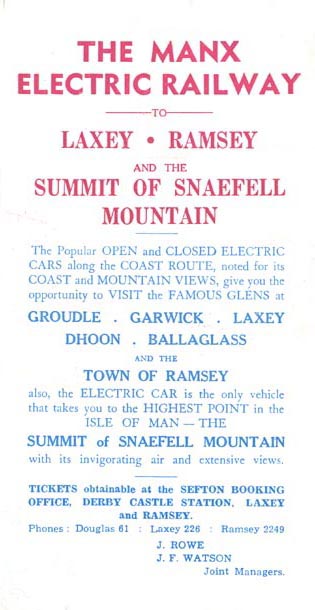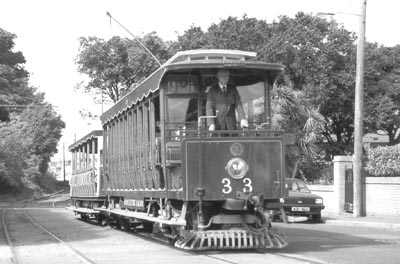|
|
|
|
|
|
|
|
|
|
|
It is perhaps not generally appreciated by the novitiate traveller, that the M.E.R. has a system of geographical references, unique to its own location and circumstances, and which allow for the very precise definition of landside locations. As well as general references by staff to 'seaside' and 'landside', M.E.R. rolling stock is designed to have a 'Douglas' or 'Ramsey' end (in contrast to the more usual practice of a No.1 or No.2 end), owing to the fact that the cars are not normally turned in traffic. Tram motors and wheelsets are numbered in sequence (from the Douglas end) 1, 2, 3 and 4. Thus a defective axlebox bearing (an unusual occurrence), might be found on landside No.3 axle. Add to this the numbering of all the M.E.R.'s traction poles, including pull offs, starting beside Derby Castle Booking Office in Douglas with No.1, the location of breakdowns, defective track or overhead, sleepers or whatever, can be easily and readily passed on to those who need to know, by reference to the traction pole nearest to it. Every pole carries a plastic tag carrying it's number. Long serving employees can quote locations and exact pole numbers from memory. As a guide to the line's geography, we now provide a list of the M.E.R.'s stopping places and their associated pole numbers. The railway provides a valuable social service and its convenience and accessibility is valued by those who rely upon it for their daily transport needs. A recent welcome development is that each tram stop including nearly all of the previously unmarked lineside halts, have now received individually named tram stop signs. They are in the style of standard IOM Transport bus stop flag, with a tram outline instead of a bus. The appearance of these tram stop signs is to be applauded. For many years the Manx Electric Railway Society advocated the introduction of such a feature through the pages of its journal and elsewhere. In addition over the last couple of years a number of previously unsheltered stops have had standard 'Macemain and Amstad' bus shelters erected, often acting as a joint bus/rail shelter. Whilst not totally in-keeping with the traditional appearance of the line the inclusion of passenger facilities, where none previously existed, is welcomed. |
|
|
|
|
|
|
|
|
|
|
|
|
|
|
|
|
|
|
|
|
|
|
|
|
|
|
|
|
|
|
|
|
|
|
|
|
|
|
|
|
|
|
|
|
|
|
|
|
|
|
|
|
|
|
|
|
|
|
|
|
|
|
|
|
|
|
|
|
|
|
|
|
|
|
|
|
|
|
|
|
|
|
|
|
|
|
|
|
|
|
|
|
|
|
|
|
|
|
|
Minorca shelter was formerly erected at Half-way house in 1900. This is the most convenient stop for Old Laxey. |
|
|
|
|
|
|
|
|
|
|
|
|
|
|
|
|
|
|
|
|
|
|
|
|
|
|
|
|
|
|
|
|
|
|
|
|
|
|
|
|
|
|
|
|
|
|
|
|
|
|
|
|
|
|
|
|
|
|
|
|
|
|
|
|
|
|
|
|
|
|
|
|
|
|
|
|
|
|
|
|
|
|
|
|
|
|
|
|
|
|
|
|
|
|
|
|
|
|
|
|
|
|
|
|
|
|
|
|
|
|
|
|
|
|
|
|
|
|
|
|
|
|
|
|
|
|
|
|
|
|
|
|
|
|
|
|
|
|
|
|
|
All Photos : A. Spencer ©








